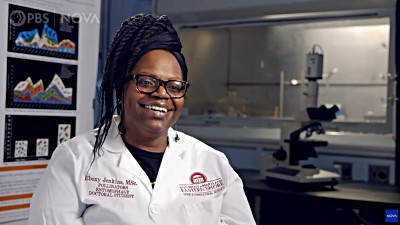
What tastes like shrimp or seafood? It might have a “citrusy flavor” or be “oily and salty like popcorn.” Could be crunchy like a “Frito or chip” or “smushy like pudding.” They come in all shapes and sizes, and if you guessed edible insects, a world food protein source on the rise, you guessed correctly.
“Five years ago I was deathly afraid of insects, so I went from running from them, to chasing them, to eating them—now that’s revenge!,” said Ebony Jenkins, a food and agricultural sciences doctoral student at the University of Maryland Eastern Shore.
Jenkins is a budding entomophagist. No, it’s not misspelled. The field is not entomology, more commonly known, it’s entomophagy—the study of rearing insects for human consumption, feed and biological controls. She and her research advisor, Dr. Simon Zebelo, an associate professor of entomology and plant biology, tout cicadas, crickets and mealworms among others as a safe, economical and nutritious source of protein.
Their thoughts and research have gained national attention. The Public Broadcasting System’s premiere science series, NOVA, featured Jenkins on its Season 48, Episode 14 “Edible Insects,” which aired for the first time on Wednesday, October 20.
“I didn’t know it was showing, I just ran across it,” Jenkins said. “I couldn’t believe it! I have watched it 10 times since airing. I’m still in shock and grateful for the opportunity. They could have chosen anyone, but they choose me.”
Jenkins weighed in on the documentary on her work focusing on improving insects as a source of nutrition and modifying what they eat.
“One of my objectives is to understand the optimization of feed for various insects,” she explained. “You are what you eat, so whatever they eat they’re able to metabolize and we can benefit from those items that are present in their system. So, for example, if you add more calcium or more of something like that to their diet they are able to ingest that and pass that on (to whatever eats them).”
“The trick for researchers like Ebony,” the announcer reads, “is to create a diet that insects will not only choose to eat, but which loads them with bonus nutrients. But beyond nutrients, Ebony wants to investigate the potential for food to deliver medicines. Her focus is on CBD from cannabis.”
“We are analyzing the crickets to see how they metabolize CBD for medicinal purposes. We just add those drops (of cannabidiol) to the feed and mix it up and we’re just going to let them eat it and see what the CBD is doing inside of the cricket.” The research ties in with other multi-disciplinary research taking place through UMES’ Industrial Hemp Program.
“If Ebony is successful,” the announcer reads, “insects bred on customized food could one day treat both your hunger and your health.”
But is the U.S. ready?
“I believe that there are going to be many opportunities. This is going to open the door for a lot of people, and we’re going to be seeing insect-based products soon on our shelves,” Jenkins said. “What I would say to anyone that’s nervous (about eating insects) is, I’m right there with you still, I’m right there with you still.”

Why eat insects? What’s wrong with continuing to consume meat?
“Over two million people in the world currently consume insects as a protein source,” Jenkins said. “The insect-based world food market is currently valued at $105 million and is estimated to grow to $1.5 billion by 2021. Although the trend has not been readily adopted in the U.S., consuming insects makes sense economically and environmentally, she said, since insects use less energy, feed, land and water to raise than livestock.”
Not only are they economically and environmentally ideal, they are also nutritious and plentiful. Of known animal species, two-thirds are insects. Edible insects, and there are over 2,000 varieties, are full of polyunsaturated fat, trace minerals and micronutrients and, especially, protein.
“Crickets contain more than twice the amount of protein compared to steak on the same weight basis,” Jenkins said. “Crickets and mealworms raised on U.S. farms have also been shown to lack common foodborne pathogens such as salmonella, staph, E. coli and listeria.”
“Research is in its early days, but Ebony’s confidence is high,” the announcer reads.
“Once we have the (research) findings,” she said. “I believe that it’s going to take off, because people want to know how they can become healthier, and if we can make people’s lives better—we did our job.”
The Snow Hill, Maryland, native transferred to UMES after earning an associate’s degree at Wor-Wic Community College. She went on to complete bachelor’s and master’s degrees at UMES in food and agriculture focusing on host preference and population dynamics in arthropod pollinators.
Gail Stephens, agricultural communications, University of Maryland Eastern Shore, School of Agricultural and Natural Sciences, gcstephens@umes.edu, 410-621-3850.

